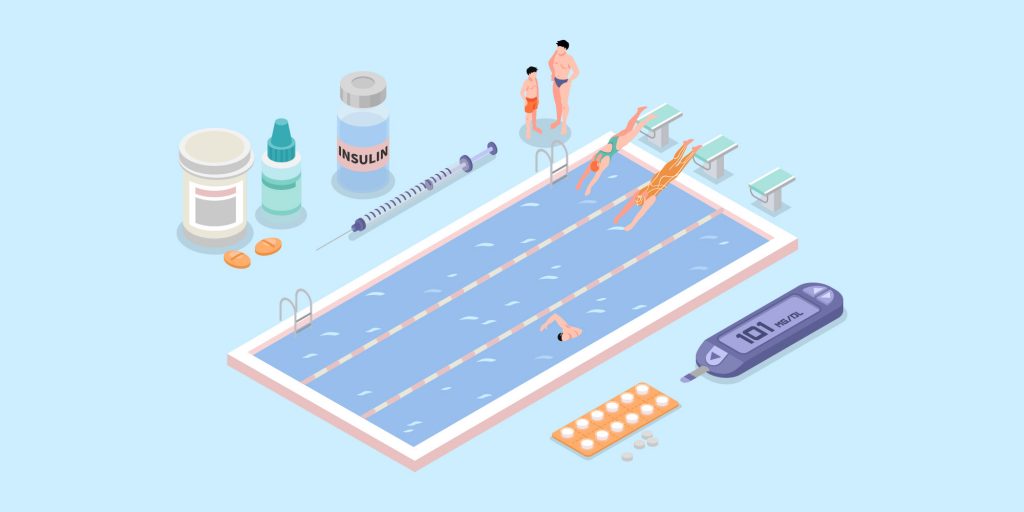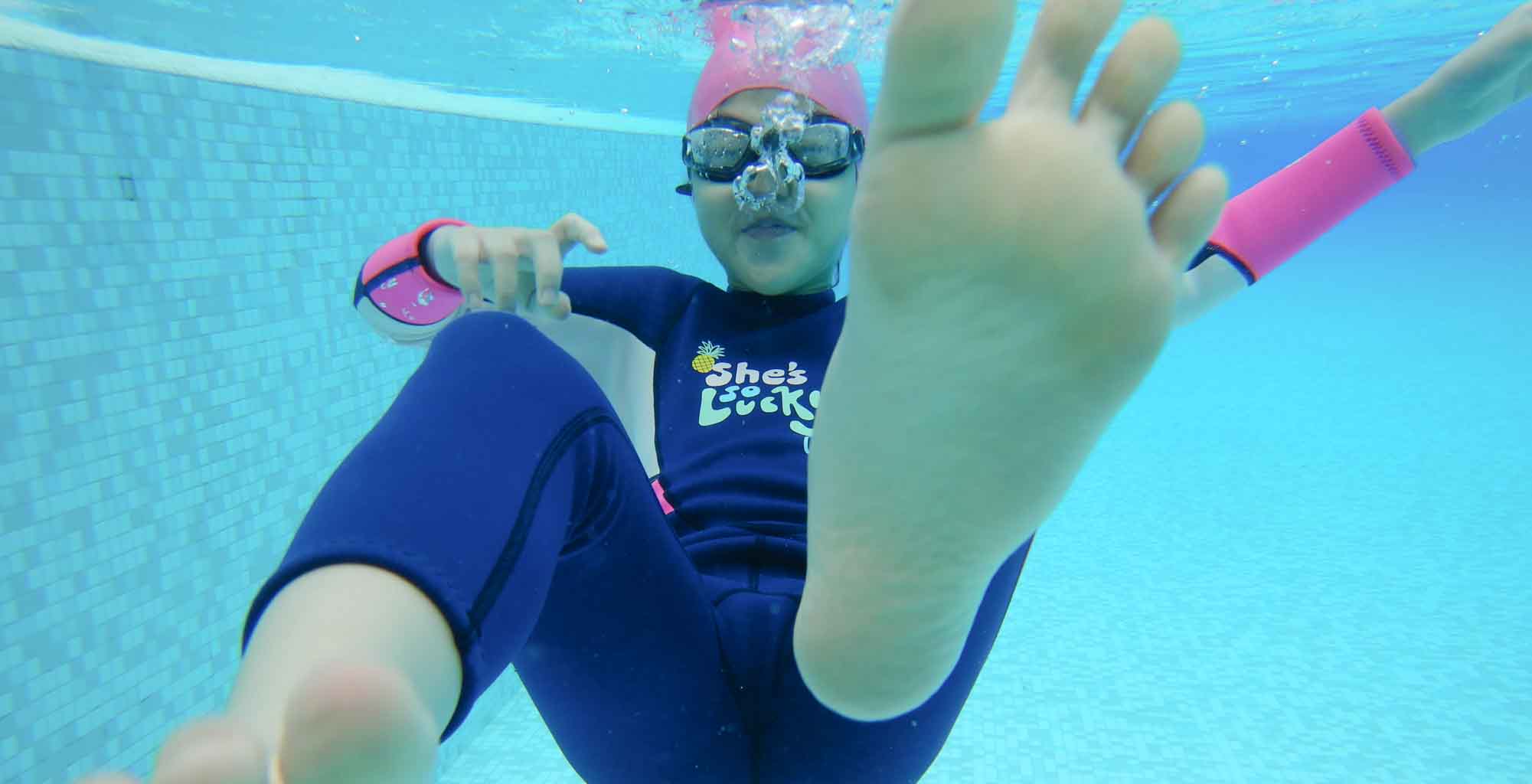Benefits Of Swimming With Diabetes

Regular swimming can be an excellent form of exercise for those with Diabetes because of its physical benefits.
Continue reading to learn more about swimming and Diabetes, including what safety measures to take at the pool and how swimming can help you control your blood sugar levels.
Describe Diabetes.
Elevated blood glucose levels characterize Diabetes, sometimes referred to as blood sugar. The most prevalent types of Diabetes are Type 1, 2, and gestational Diabetes. However, there are other types as well.
Your pancreas cannot produce any insulin if you have Type 1 diabetes. A hormone called insulin transports sugar from the blood into the cells, where it is used as fuel. Your pancreas either doesn’t produce enough insulin, or the insulin it does produce can’t function correctly if you have type 2 diabetes (you have insulin resistance).
Injections or an insulin pump must replace insulin to treat Type 1 diabetes. In addition, a healthy diet and way of living assist in lowering the risk of long-term diabetic consequences such as heart disease, kidney disease, nerve damage, and vision loss.
People with Type 2 diabetes can manage their illness with a healthy diet and way of life, but many also need to take medicine, which may come from pills, injectable drugs, and insulin.
Pregnant women can develop gestational Diabetes, commonly in the second or third trimester. This occurs because your body may struggle to correctly utilize insulin as a result of the hormones released during pregnancy, increasing your risk of developing insulin resistance.
The body occasionally cannot produce enough insulin during pregnancy to overcome this resistance. Treatment options for gestational Diabetes include insulin, medication, nutrition, and lifestyle changes.
What You Should Know About Swimming & Diabetes
People living with Diabetes benefit significantly from swimming. It can lower the risk of cardiovascular disease and assist with gestational and Type 2 diabetic blood sugar management. In addition, it improves insulin sensitivity and helps people lose weight or keep their weight at a healthy level.
Swimming shouldn’t be impossible for those with Diabetes, but there are a few things to remember:
- Checking blood sugar levels
- Many people with Diabetes will be required to perform at-home blood sugar tests, especially if they take insulin or other drugs like sulphonylureas to treat their disease (low blood sugar levels).
- Testing your blood sugar levels while exercising might help you understand its impact.
- medicines for Diabetes
Swimming can also result in lower-than-normal blood sugar levels if you treat your Diabetes with insulin or drugs that can raise your risk of a hypoglycemic episode (such as sulphonylureas). Before beginning any new exercise, talk to your healthcare team; they can assist you with worries like hypos.
Additionally, those with Diabetes who take insulin to manage their illness may be more susceptible to hypos (low blood sugar levels) for several hours (24–48 hours) following exercise. How effectively your body uses insulin to lower blood sugar levels is known as insulin sensitivity. Insulin usage is decreased in persons with high sensitivity compared to those with low sensitivity.
You might need to change the amount of your basal (long-acting) or bolus (short-acting) insulin when you swim. For instance, you may need to lower your bolus (or mealtime) insulin dose the closer your last meal or snack is before your swim. These adjustments might be required for insulin pens or pumps.
Your diabetes healthcare team can provide personalized advice as this is highly individual.
Insulin Kit
Manufacturers can advise on how water resistant your specific model is for those who use insulin pumps. In addition, you may be able to disconnect for up to an hour at a time, so your diabetic healthcare team can provide personalized guidance.
Additionally, manufacturers will know if equipment like continuous glucose monitoring or flash glucose monitors is waterproof. However, checking with the monitor’s manufacturer is recommended because every model is unique.
Low and high blood sugar
Depending on the activity and how vigorous it was, the impact exercise has on your blood sugar levels varies from person to person and can result in lower or higher levels.
When swimming or engaging in other forms of exercise, you might not be able to recognize the signs of a hypo. This is because of the similarity in how pushing oneself and experiencing a hypo can feel.
You should discuss the blood sugar levels to aim for before and after exercise with your diabetes healthcare team to ensure you exercise safely.

Difficulties With Diabetes
It’s advisable to consult with your diabetic healthcare provider before beginning a new fitness regimen if you have a complication of Diabetes.
Every day, check your feet. After swimming, you should keep doing this to avoid any issues.
Find out if it’s safe for you to dive if you have retinopathy. However, this does not preclude you from swimming. People with Diabetes are more likely to develop retinopathy, a type of eye disease. It takes place when the retina’s blood vessels suffer damage.
Techniques for Swimming While Diabetic
Do: If swimming is a new exercise, talk to your diabetic healthcare provider. Ask them how to regulate your insulin intake when exercising if you treat your Diabetes with insulin.
If you regularly test your blood sugar, do it at least 30 minutes before swimming and then adjust your strategy based on the results. For example, if your level is between 4 and 7 mmol/l, you should treat hypos as normal but may additionally need an additional snack before swimming.
If you use insulin or other medications that can raise your risk of hypos, carry hypo therapy (like sulphonylureas). Tell the lifeguard you have Diabetes and keep these by the pool.
If you usually monitor your blood sugar at home, do so while swimming. It’s beneficial to see how swimming affects your blood sugar levels. With this information, you and your diabetes healthcare team can determine the most effective strategy for controlling blood sugar while exercising.
After you swim, look for any scrapes or grazes you could have received from the pool’s edge, and make sure they heal properly. If you have any worries or your wounds are not healing, ask the diabetic treatment team for assistance.
To prevent injuries and lower your risk of developing conditions like verrucas, walk around the pool with flip-flops or other similar footwear.
Carry your diabetic identification card, and let someone know you have Diabetes—perhaps the person in charge of the pool.
Don’t:
You might not need to test your blood sugar levels at home, so don’t worry if you aren’t doing so. Enjoy your swim, but if you have any questions or concerns before beginning, talk to your diabetic treatment team.
Avoid:
If you’ve recently experienced severe hypoglycemia, go swimming.
With your diabetic healthcare team, you should also discuss a plan for what to do if your blood sugar levels are high. For example, if your blood sugar levels are higher than 13 mmol/l, you should check for ketones in your blood or urine and possibly reevaluate the type of exercise you are about to conduct. It might be suggested that you avoid exercising in this situation.
Remember:
After exercise, increased insulin sensitivity may last for several hours. As a result, you must continue to check your blood sugar, especially before night.
Specific Advice on Swimming and Diabetes
Consider supplementary advice if you want to swim in open water or overseas.
Outdoor Swimming
Consider the water’s temperature. If you are out in open water, hypothermia may be more challenging to treat and can increase your risk of occurring.
Before entering the water, always wear the proper footwear. This will shield your foot from the elements and dangerous things.
Outdoor Swimming and Diabetes
To be safe, always bring a duplicate of your prescription and more medication and supplies than you typically use.
Bring a note from the diabetic treatment center with you.
As temperature fluctuations might alter blood sugar levels, you should check your blood sugar levels more frequently.
Make sure to keep your insulin and diabetes kit at the proper temperature.


